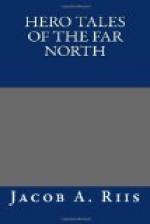The binomial system revolutionized the science. What the lines of longitude and latitude did for geography Linnaeus’ genius did for botany. And he did not let pride of achievement persuade him that he had said the last word. He knew his system to be the best till some one should find a better, and said so. The King gave him a noble name and he was proud of it with reason—vain, some have said. But vanity did not make the creature deny the Creator. He ever tried to trace science to its author. When the people were frightened by the “water turning to blood” and overzealous priests cried that it was a sign of the wrath of God, he showed under the magnifying glass the presence of innumerable little animals that gave the water its reddish tinge, and thereby gave offence to some pious souls. But over the door of his lecture room were the words in Latin: “Live guiltless—God sees you!” and in his old age, seeing with prophetic eye the day of bacteriology that dawned a hundred years after his death, he thanked God that He had permitted him to “look into His secret council room and workshop.”
He was one of the clear thinkers of all days, uniting imagination with sound sense. It was Linnaeus who discovered that plants sleep like animals. The Pope ordered that his books, wherever they were found in his dominions, should be burned as materialistic and heretical; but Linnaeus lived to see a professor in botany at Rome dismissed because he did not understand his system, and another put in his place who did, and whose lectures followed his theories. When he was seventy he was stricken with apoplexy, while lecturing to his students, and the last year of his life was full of misery. “Linnaeus limps,” is one of the last entries in his diary, “can hardly walk, speaks unintelligibly, and is scarce able to write.” Death came on January 10, 1778.
Under the white flashes of the northern lights in the desolate land he explored in his youth, there grows in the shelter of the spruce forests a flower which he found and loved beyond any other, the Linnaea borealis, named after him. In some pictures we have of him, he is seen holding a sprig of it in his hand. It is the twin flower of the northern Pacific coast and of Labrador, indeed of the far northern woods from Labrador all the way to Alaska, that lifts its delicate, sweet-scented pink bells from the moss with gentle appeal, “long overlooked, lowly, flowering early” despite cold and storm, typical of the man himself.
NIELS FINSEN, THE WOLF-SLAYER
Hard by the town of Thorshavn, in the Faroee islands, a little lad sat one day carving his name on a rock. His rough-coated pony cropped the tufts of stunted grass within call. The grim North Sea beat upon the shore below. What thoughts of the great world without it stirred in the boy he never told. He came of a people to whom it called all through the ages with a summons that rarely went unheeded. If he heard he gave no sign. Slowly and laboriously he traced in the stone the letters N.R.F. When he had finished he surveyed his work with a quiet smile. “There!” he said, “that is done.”




